Felicia petiolata
Felicia petiolata (Harv.) N.E.Br.
Family: Asteraceae
Common names: Lesotho felicia, creeping blue marguerite (Eng.); khotolia-ea-thaba, morarana (Sesotho)
Introduction
An attractive evergreen, low-growing felicia with yellow-centred, rose pink daisy-like flowers in summer, and dentate leaves on long stems.
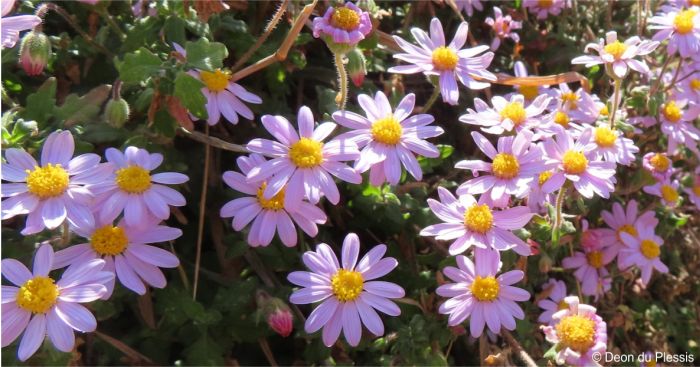
Description
Description
Felicia petiolata is a perennial, evergreen sub-shrub that grows 200 to 300 mm in height. The plant has a woody base, with many stems from the crown. The stems are very long, reaching up to about 900 mm in length, prostrate or pendulous, sparsely leafy throughout, giving the plant a low-growing, rounded habit and often forming large tangled masses. Young twigs are firm, upright and hairy. The leaves are, simple, alternate, on slender stalks (petioles) up to 6 mm long, lanceolate to obovate, coarsely toothed (dentate), thinly hairy, up to 25 x 15 mm, rather papery, and slightly gland-dotted on both sides, with indistinct lateral nerves. Flower bearing stalks (peduncles) are sometimes about 70 mm long, sparingly leafy, bearing solitary, terminal flower heads, 20-38 mm in diameter, carried well above the foliage, in masses in spring and summer (October to February). Flowers are attractive, light pink, daisy-like, they have yellow centres and about 12 mauve to rose pink ray florets that turn blueish with age. The fruits are compound and compressed into seedlike achenes.
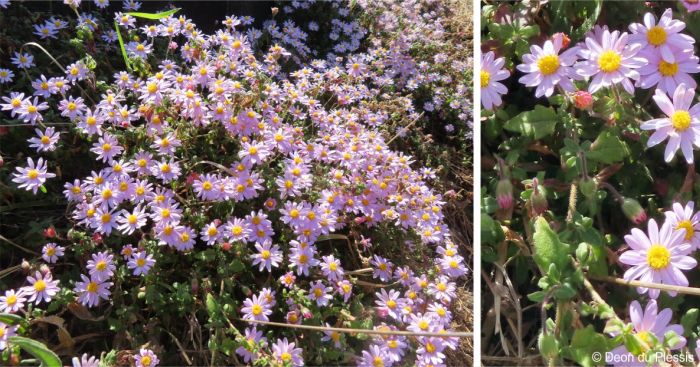
Conservation Status
Status
Felicia petiolata is not threatened. The conservation status of this plant is assessed as Least Concern (LC), according to the SANBI Red List of South African Plants.
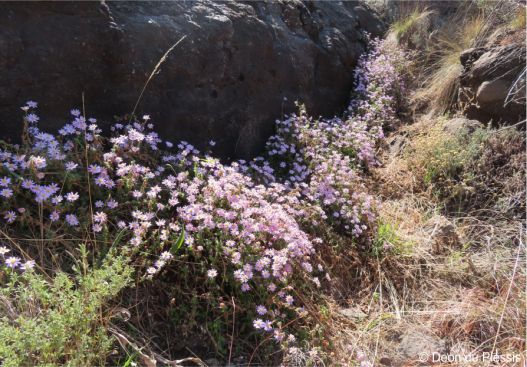
Distribution and habitat
Distribution description
Felicia petiolata is endemic to southern Africa, it is distributed in the Drakensberg Mountains in Lesotho and South Africa, where it occurs in the Eastern Cape, Free State and KwaZulu-Natal provinces, and is seen growing at the foot of damp cliffs or hanging over steep rocks, at 1 800-2 250 m altitude. This perennial prefers a sunny environment on moderately moist soil. The substrate should be sandy loam. Felicia petiolata tolerates low temperatures to about -7˚C. It is drought resistant and grows well in semi-shade and full sun. Its flowering season is in winter, spring, early summer and late summer. Felicia petiolata thrives among rocks, shielded from the wind and in an environment that is not too damp. Under these conditions, it is resilient in northern climates and can withstand harsh winters.
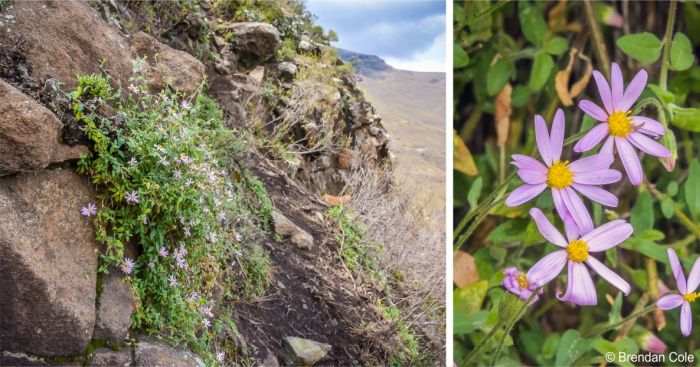
Derivation of name and historical aspects
History
Felicia petiolata was first described and published by William Henry Harvey in 1863, he called it Aster petiolatus. It was then revised and renamed Felicia petiolata by Nicholas Edward Brown in 1906. The genus Felicia was possibly named after a German official, Herr Felix who died in 1846, or the name could be derived from the latin felix meaning ‘happy’ or ‘cheerful’. The species name petiolata means ‘stalked’, which refers to the leaf stalks (petioles) of the plant which are long when compared to other Felicia species.
Felicia petiolata was first collected by T. Cooper in 1861 in Lesotho, then called Basutoland when it was part of the Cape of the Good Hope in South Africa. The genus Felicia has about 80 species, most of which are indigenous to southern Africa. Species of this genus are either non-hardy shrubs, annuals, subshrubs or herbaceous perennials. They belong in the Asteraceae, one of the largest families of flowering plants. The alternative name for Asteraceae is Compositae, derived from the Latin word compositus, which means ‘made up of components united in one common whole’. This refers to the arrangement of different flowers in an inflorescence.
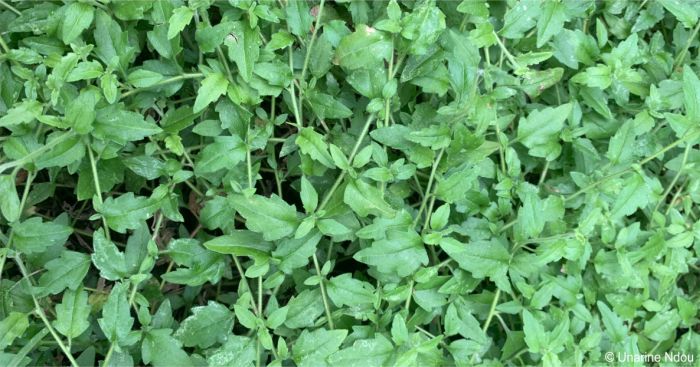
Ecology
Ecology
Felicia flowers are pollinated by insects such as butterflies, wasps and bees, and the flowers are also frequented by thrips. The seeds are dispersed by wind.
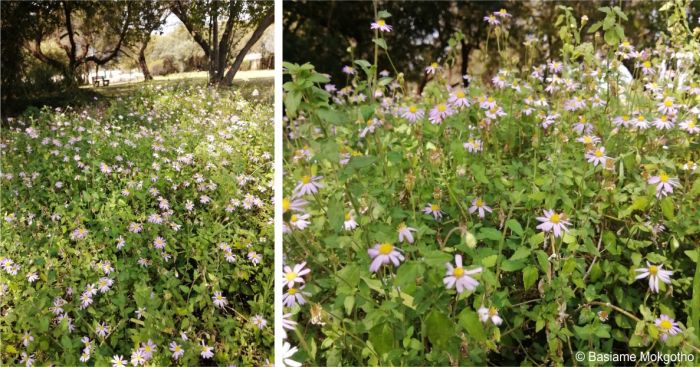
Uses
Use
Felicia petiolata is an ornamental plant that can be used in gardens and landscapes, its long blooming period gives attractive colour in a flower-bed. It is ideal for mixed borders, rock gardens, retaining walls or embankments and it can be planted as a ground cover, in sun or semi-shade. It also makes a decorative pot plant, and is ideal for hanging baskets. It is traditionally believed to encourage a good harvest. There are no reports of medicinal usage for human health.
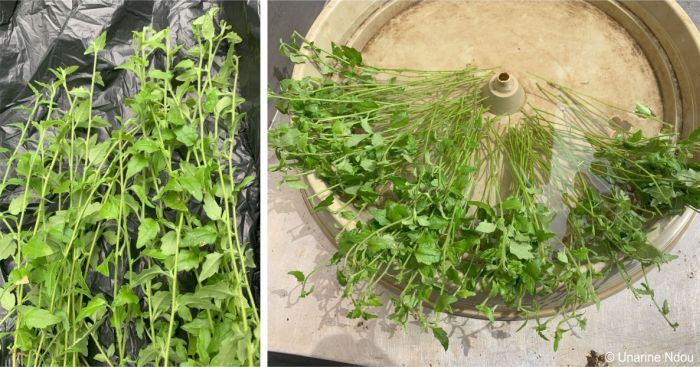
Growing Felicia petiolata
Grow
Felicia petiolata can be propagated by stem cuttings or seeds. When propagating from stem cuttings, collect cuttings from a healthy mother plant, early in the morning while the mother plant still retains enough moisture. Dip cuttings into a rooting hormone suitable for soft-wood cuttings to promote quick rooting. Place the cuttings into a well-drained growing medium, such as river sand. Irrigate twice a day on sunny days and once on cool, cloudy days. After three to four weeks, the cuttings should be ready to be transplanted from the cuttings tray into 3-litre bags/pots filled with potting soil.. Irrigation should be done every day and after a week or two, the young plants will be ready for planting in the garden. Space them at least 15 cm apart.
When propagating from seeds, sow the seeds in spring or early summer in a well-drained sowing medium which can be potting soil. Make sure the soil is always moist. After germination, wait for two to three weeks for seedlings to develop. After development, seedlings will be ready for transplantation. Leave the transplanted seedlings to harden-off for a week. After hardening-off, they can be planted in the garden. Once the plants are established, their growth rate is very fast.
Grow Felicia petiolata in semi-shade or full sun, in well-drained loamy soil. This is a water-wise and cold hardy plant. Apply general fertilizer and compost to strengthen and give the plant an attractive and healthy appearance and to enhance the stability of the plant. Prune to shape when flowering is complete, or just before new growth begins in spring.
References
- Cole, B. 2018-Oct Observation of Felicia petiolata, Rhodes Village Common, Eastern Cape. iNaturalist. Online. https://www.inaturalist.org/observations/17463737.
- Cooper, T. 1861 Herbarium specimen of Felicia petiolata (Harv.) N.E.Br. JSTOR Global Plants. http://plants.jstor.org/stable/10.5555/al.ap.specimen.k000273761. Accessed on 12/02/2024.
- Cotswold Garden Flowers. Felicia petiolata Harv. N.E. Br. https://www.cotswoldgardenflowers.co.uk/encyclopedia/felicia-petiolata/. Accessed on 12/02/2024.
- Du Plessis, D. 2021-Sep. Observation of Felicia petiolata, Joubert’s Pass, Lady Grey, EC. iNaturalist. Online. https://www.inaturalist.org/observations/96398233.
- Everett, T.H. 1980. The New York botanical garden illustrated encyclopedia of horticulture Vol. 10. Taylor & Francis, New York.
- Harvey, W.H. 1863. Aster petiolatus Harv. Thesaurus Capensis 2:35. Accessed via Biodiversity Heritage Library. https://www.biodiversitylibrary.org/page/2898330#page/37/mode/1up.
- Herman, P.P.J. 2004. Asteraceae. (Compositae). PlantZAfrica. Online. http://pza.sanbi.org/Asteraceae.
- Hortipedia. Felicia petiolata (Harv.) N.E.Br. https://en.hortipedia.com/Felicia-petiolata. Accessed on 12/02/2024.
- Jackson, W.P.U. 1990. Origins and meanings of names of South African plant genera. University of Cape Town.
- Mokgotho, B. Observation of Felicia petiolata, Free State National Botanical Garden, Free State. iNaturalist. Online. https://www.inaturalist.org/observations/138358332.
- New Zealand Plant Conservation Network. Felicia petiolata. http://nzpcn.org.nz/flora/species/felicia-petiolata/. Accessed on 12/02/2024.
- Ntloko, B. 2010. Felicia petiolata. Flora of The Mountain Kingdom. The Blanketwrap. Online. http://lesotho-blanketwrap.com/2010/flower-of-the-month/felicia-petiolata/.
- Pooley, E. 2003. Mountain flowers, a field guide to the flora of the Drakensberg and Lesotho. Natal Flora Publications Trust, Durban.
- Prain, D. (ed). 1911. Felicia petiolata. Curtis’s Botanical Magazine Vol 7. 4th series. Tab. 8370. Accessed via Biodiversity Heritage Library https://www.biodiversitylibrary.org/item/14263#page/78/mode/1up.
- Raimondo, D., Von Staden, L., Foden, W., Victor, J.E., Helme, N.A., Turner, R.C., Kamundi, D.A. & Manyama, P.A. (eds) 2009. Red list of South African plants. Strelitzia 25. South African National Biodiversity Institute, Pretoria.
- Vicflora Flora of Victoria. Felicia petiolata Harv. N.E.Br. Blue Felicia. http://vicflora.rbg.vic.gov.au/flora/taxon/17ac9657-8c58-4683-945c-bb46650137b1. Accessed on 12/02/2024.
Credits
Unarine Honest Ndou and Nthabiseng Lucia Masetla
Walter Sisulu National Botanical Garden
September 2024
Acknowledgements: additional images by Deon du Plessis, Basiame Mokgotho and Brendan Cole.
Plant Attributes:
Plant Type: Ground Cover, Scrambler, Shrub
SA Distribution: Eastern Cape, Free State, KwaZulu-Natal
Soil type: Sandy, Loam
Flowering season: Spring, Early Summer
PH: Acid, Neutral
Flower colour: Pink, Yellow, Mauve/Lilac
Aspect: Full Sun, Morning Sun (Semi Shade), Afternoon Sun (Semi Shade)
Gardening skill: Easy
Special Features:
Horticultural zones











Rate this article
Article well written and informative
Rate this plant
Is this an interesting plant?
Login to add your Comment
Back to topNot registered yet? Click here to register.